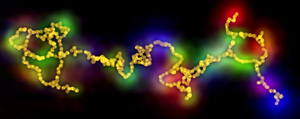Gold ‘necklaces’ add sparkle to information processing

A 750-nanometer-long network of gold nanoparticles (yellow). The colors around the network show where different colors of light are localized. © 2015 A*STAR Institute of Materials Research and Engineering
A way to transport highly confined light energy over long distances using extended networks of partially fused gold nanoparticles has been demonstrated by an international team of researchers [1]. This demonstration raises the possibility of new options for information processing by realizing extremely miniaturized light guidance and may lead to advances in sensors and telecommunication systems.
“Our approach has all the versatility that chemistry involving colloids offers and could be used to fabricate miniaturized optical networks,” explains Michel Bosman of the A*STAR Institute of Materials Research and Engineering in Singapore.
Light travels rapidly, making it a highly attractive medium for transmitting information. Currently, optical fibers are used to transport optical signals over long distances, but they are unsuitable on small scales as their dimensions cannot be shrunk much below the wavelength of light. One promising approach is to use light-induced oscillations of electrons (known as surface plasmons) on nanoparticles, but until now it had not been possible to couple plasmons between large numbers of touching nanoparticles.
Bosman, together with collaborators at CEMES in France and at Bristol in the United Kingdom, devised a way to propagate surface plasmons over long chains of gold nanoparticles. This allowed them to miniaturize the transport of highly confined light over distances that are long enough to be useful for optical circuits.
The researchers synthesized gold nanoparticles that were 12 nanometers in diameter and self-assembled them into networks by adding the compound mercaptoethanol. They then ‘welded’ the nanoparticles together by irradiating them with a high-energy electron beam.
The team investigated the light propagation properties of the networks using a technique known as electron energy-loss spectroscopy. These measurements demonstrated that the networks form pathways along which light energy can travel as surface plasmons (see image).
The results were much clearer than the researchers expected. “We were surprised to see that the surface plasmons were not weakened much by the grain boundaries that exist between neighboring nanoparticles,” says Bosman. “Our networks contain hundreds of grain boundaries, and yet the surface plasmons would oscillate across them mostly unhindered.”
In the future, the team hopes to produce designer networks using their nanoparticles. “Currently, we cannot control the design of our nanoparticle networks in detail,” says Bosman. “We intend to combine our technique with lithography to gain full control over their length and shape and form designed optical networks made with colloidal nanoparticles as building blocks.”
The A*STAR-affiliated researchers contributing to this research are from the Institute of Materials Research and Engineering
Reference
[1] Teulle, A., Bosman, M., Girard, C., Gurunatha, K. L., Li, M., Mann, S. & Dujardin, E. Multimodal plasmonics in fused colloidal networks. Nature Materials 14, 87–94 (2015).
Associated links
A*STAR Research article
Media Contact
More Information:
http://www.researchsea.comAll latest news from the category: Information Technology
Here you can find a summary of innovations in the fields of information and data processing and up-to-date developments on IT equipment and hardware.
This area covers topics such as IT services, IT architectures, IT management and telecommunications.
Newest articles

Security vulnerability in browser interface
… allows computer access via graphics card. Researchers at Graz University of Technology were successful with three different side-channel attacks on graphics cards via the WebGPU browser interface. The attacks…

A closer look at mechanochemistry
Ferdi Schüth and his team at the Max Planck Institut für Kohlenforschung in Mülheim/Germany have been studying the phenomena of mechanochemistry for several years. But what actually happens at the…

Severe Vulnerabilities Discovered in Software to Protect Internet Routing
A research team from the National Research Center for Applied Cybersecurity ATHENE led by Prof. Dr. Haya Schulmann has uncovered 18 vulnerabilities in crucial software components of Resource Public Key…





















